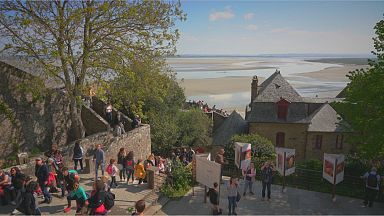After around 20 years of research and construction work, Mont Saint Michel has recovered its isolated character, thanks to a new dam and footbridge.
It sits off the coast of Normandy, looking like a fairytale castle floating on the water.
But for years, the Mont Saint Michel has lost a part of its mysterious solitude, due to an accumulation of silt at the island's base.
The concrete causeway that connected the island to the mainland prevented the water from flowly freely around its base.
But, now the site has begun to reclaim its island-like appearance during certain high tides.
Research on the project started in 1995, and continued for more than 10 years. It then took another 10 years to complete the major structural changes.
Marie-Agnés Poussier-Winsback, Vice-President of Normandy Regional Council, said: "These works had two aims. Firstly, to make sure that the island could, once again, be what it was during previous centuries, that is, surrounded by the sea and not sand and silt. And secondly, to improve the way we manage tourism."
The main work undertaken was the removal of the concrete causeway. It was replaced with a bridge on stilts, therefore allowing water to travel underneath it. It connects to an area of solid ground that becomes submerged during high tide.
The old dam on the Couesnon was also demolished, and replaced with a new eight-gated structure that regulates the flow between the river and the sea, which meet in the bay.
Romain Desguée, who manages the new dam, explained to Euronews how it works.
"The old dam was there to limit flooding and marine flooding. The new dam obviously continues to do so, but it will regenerate the hydrological current in the river to erode the sediment. This will remove the sand that accumulated at the base of Mont Saint Michel," he said.
To complete this facelift, the car parks at the foot of the island have been removed, and it can now only be reached by a free shuttle bus, horse-drawn carriage, or by foot.
More than 2.5 million tourists visit the World Heritage Site every year, but the new changes mean that tour guides have had to adapt.
Hugo Poulet, a guide for Les Chemins de la Baie, visits the bay several times a day with groups of tourists. He said that the structural changes have had an effect on his work.
"Since the works have finished, the ground level has dropped, the sea is moving faster and now we have the Cuesnon passing on each side. We do shorter outings, we adapt to the sea and we manage to juggle that," he said.
The project cost a total of €184 million. Of that, €85 million was funded by the French government, and €21.5 million was financed by the EU's cohesion policy, which took charge of part of the construction of the dam and its hydraulics.












